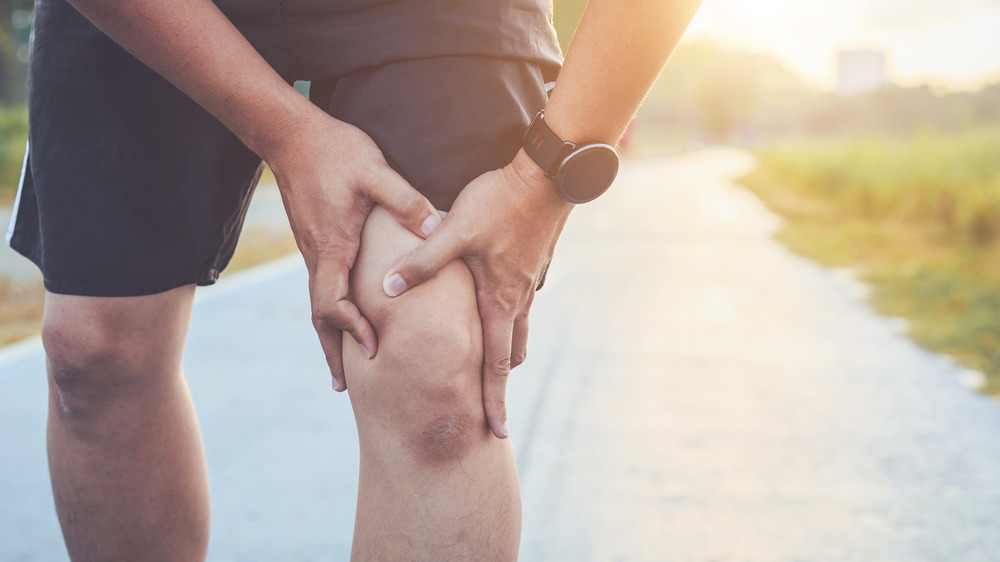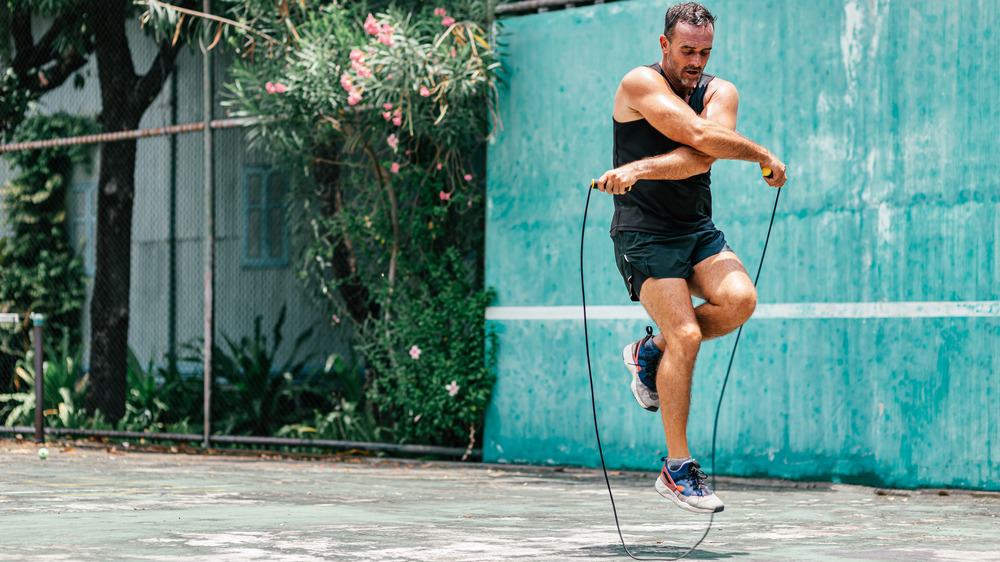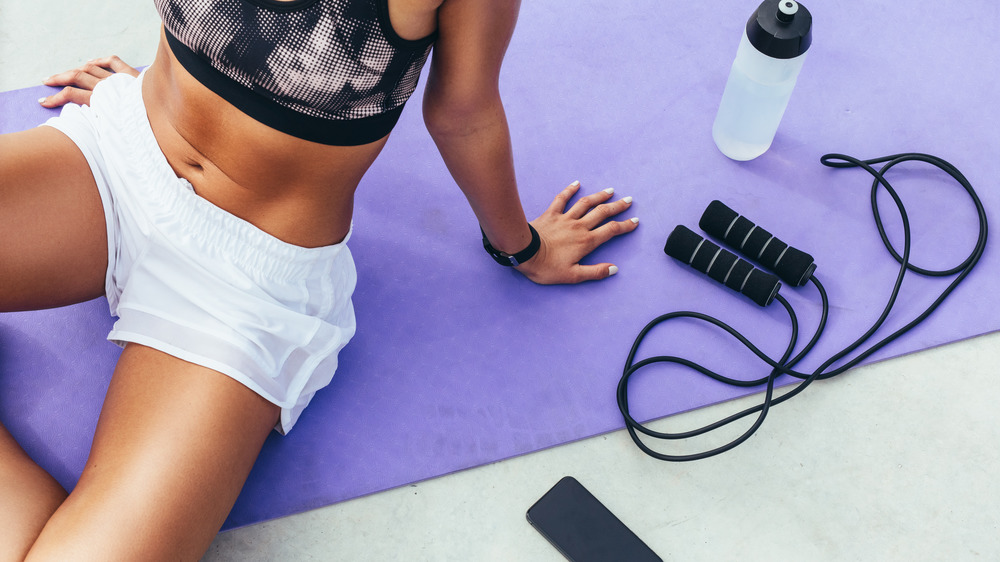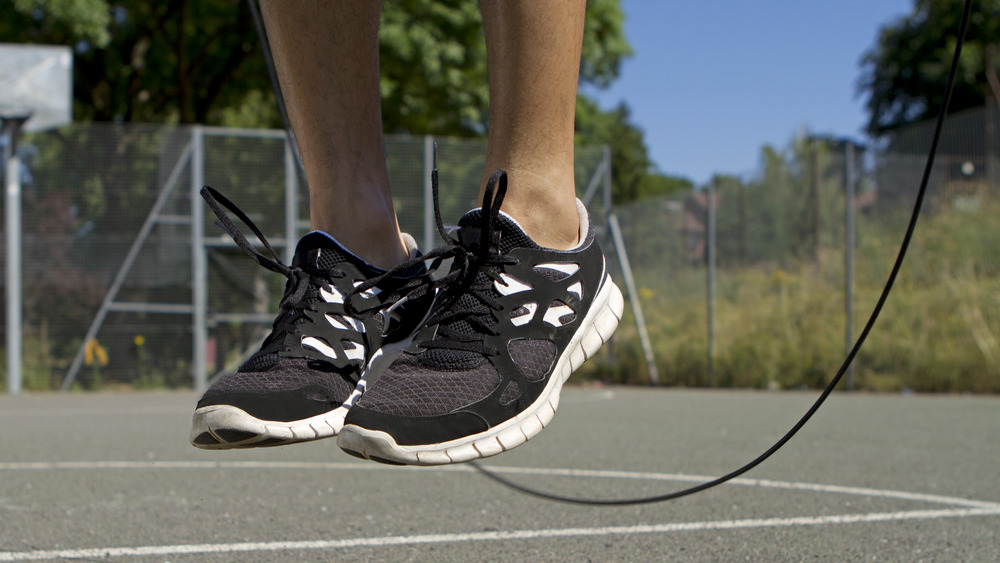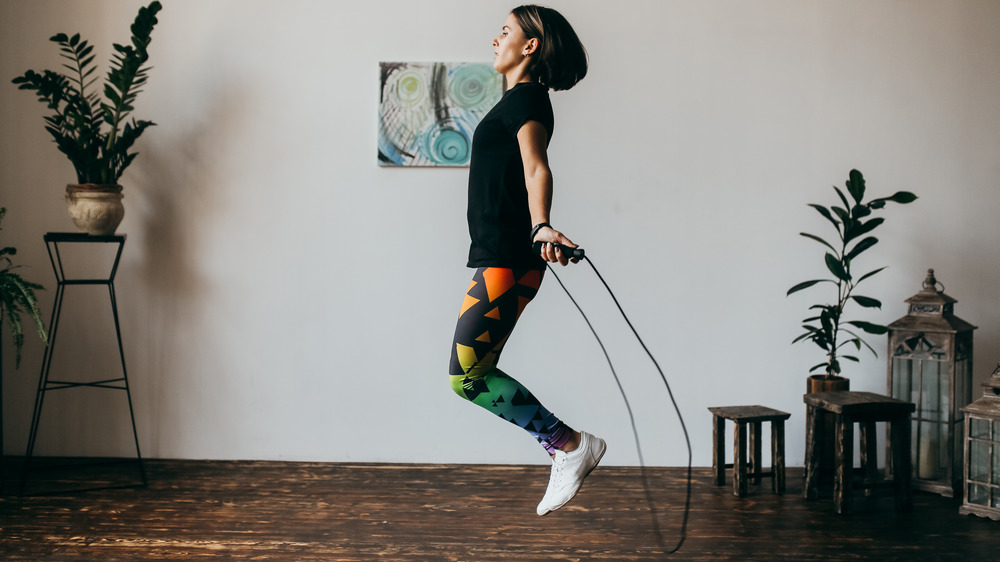When You Jump Rope Every Day, This Is What Happens To Your Body
Jumping rope was a firm favorite in the playground when we were kids — but as an adult, picking up a jump rope might not be your first choice for exercise. Although we tend to associate adults jumping rope with boxers sweating in the gym (thank you, Rocky Balboa), it can be overlooked in favor of other cardio exercises, like jogging, swimming, and weight training.
With the unstoppable rise of home workouts, however, we think it's time to give the classic jump rope another look. It's a compact and cheap piece of equipment — with many jump ropes retailing for under $20, according to WebMD. You can use it anywhere, and it's also got some huge health benefits. A hefty calorie burner, jumping rope can tone muscles all over your body, build stamina, and improve your health, among other awesome benefits (via Healthline).
But how exactly does jumping rope change your body? And if you're doing it every day, what are the effects? In this deep dive, we'll take a look at all things jump rope. Let's hop to it!
Jumping rope will strengthen your legs
Given that jumping rope relies on the nature of jumping up and down many times to produce effects, it's natural that your legs are going to be pretty heavily involved. And this is excellent news for their strength.
A 2018 study published in the Universal Journal of Educational Research found good evidence of this. Looking at two different groups, with one group participating in regular rope jumping over 10 weeks, the study found that the activity significantly improved leg strength and sprinting speed.
Jumping rope works your major leg muscles, engaging the calves, hamstrings, quads, and glutes (via Livestrong). Through a daily jump rope routine, expect all of these muscles to strengthen over time. It's useful to bear in mind, though, that as jumping rope is predicated on, well, jumping, the legs are bearing the brunt of the exercise. Make sure you get yourself a quality pair of sneakers and, as with any exercise, keep an eye out for any pain or discomfort.
Your heart health will start to improve when you start jumping rope
When jumping rope, it's easy to work up a sweat pretty quickly. You might be surprised at how much your heart rate can increase while jumping rope — especially if you're trying it for the first time or haven't done it since your younger years.
As it's cardio exercise, it means that your heart works harder as you do it — which, if done regularly, can be excellent for your heart's health (via Verywell Fit). As a study published in the Research Journal of Pharmacy and Technology found when comparing the effects of jumping rope on collegiate males, a daily jump rope workout over 12 weeks can significantly improve your cardiovascular fitness.
The study also noted that improvements in cardiovascular health due to exercise (and in the study's case, of course, jumping rope) can help reduce the risk of cardiovascular diseases such as diabetes and hypertension, and can also help to manage and reduce obesity. As such, incorporating a jump rope into your daily routine could be an excellent way to help safeguard against long-term cardiovascular illness.
Jump rope and your endurance will increase
Although jumping rope can cause even the fittest of people to get pretty out of breath, it's worth sticking with — with one of the main reasons being that jumping rope can seriously increase your exercise endurance. This is confirmed by a 2013 study published in Sports Science, which looked at the effects of regular rope jumping over seven weeks. The study found that the test subjects, on completing the period of exercise, demonstrated an over 10 percent increase in cardiovascular endurance (measured through a series of running and sprint tests).
Muscular endurance also improves when jumping rope. A study conducted by the Asia University in Taiwan revealed that 10 weeks of jumping rope improved "dynamic muscular endurance; which [is] especially important for performing stable gestures and repetitive movements."
So if you feel a little worn out after trying to jump rope the first few times, don't get too disheartened. Keep at it, and through regular doses of it, your body will soon build the endurance to help you sustain the habit.
If you're a runner, jumping rope might help ease the strain on your knees
Our knees take a lot in our day-to-day lives — and when we're exercising primarily using our legs, they see even more impact. If you're a runner, you'll know this better than most. With "runner's knee" — an irritation of the cartilage in your kneecap that causes pain — affecting up to 25 percent of male runners and 30 percent of female runners, knee problems can be an all-too-common concern (via Temple Health). Jumping rope, however, can be much easier on your knees.
In an interview with NBC New York, Dr. Lynn Millar, assistant director and associate professor of physical therapy at Michigan's Andrews University, noted exercises that flex the knee excessively or have sudden starts and stops, and running cross-country or on uneven surfaces can all put strain on the knee — whereas jumping rope could be better for knee health.
Although Dr. Millar revealed that recreational jogging shouldn't be problematic for knees with no history of problems, if you're noticing strain while running, it may be worth switching over to an activity like jumping rope.
You could seriously boost your mental health by jumping rope
The benefits of regular exercise on the body are numerous and significant. One of the biggest improvements you could see could be to your mental health. A review of studies focusing on the link between exercise and well-being published in Current Opinion in Psychiatry found regular physical activity is associated with "better quality of life" and mental health outcomes.
Even shorter bouts of exercise — like, say, a jumping rope session — can bring big benefits. Just 15 minutes a day of higher-intensity exercise could help to reduce feelings of sadness and even help prevent depression (via Harvard Women's Health Watch).
According to the Mental Health Foundation, there also exists a link between frequent physical exercise and a reduction in the risk of dementia. The foundation even cited jumping rope, specifically, as a great type of exercise. If you're thinking of taking up the high-intensity exercise, your mind will certainly reap the benefits.
You'll burn a bunch of calories jumping rope
There's a good reason why jumping rope is an excellent choice for those looking to control or reduce their weight — and that's because the amount of calories you burn while doing it is significant.
Jumping rope is a cardio exercise, meaning that your heart will work faster, you'll use more oxygen, your body will have to work harder — and, ultimately, you'll burn calories (via Verywell Fit). The more intense the cardio exercise, the more calories you'll burn. Considering jumping rope is a pretty high-intensity workout, you could end up getting big results from your workout. As WebMD indicated, jumping rope is uniquely qualified as a "calorie-burner," as people would have to run an 8-minute mile to exceed the number of calories burned skipping rope.
If you're already into HIIT workouts, which involve bursts of high-intensity exercise followed by recovery time to maximize calorie burn, consider adding a jump rope to your gym bag. It's fun and effective.
Jumping rope will improve your coordination
One of the most frustrating things about jumping rope can be the moment when, after a blissful few minutes of joyful skipping, the rope catches on your feet and stops you in your tracks — and causes quite the sting. If you're thinking of starting to jump rope every day, though, have faith. It can improve your coordination and motor skills, meaning those clumsy moments will probably get fewer and farther between.
This was shown in a 2015 study published in the Journal of Sports Science and Medicine, which looked at changes in coordination following eight weeks of jump rope training among preadolescent soccer players. The researchers found that, at the end of the study, the players who had been jumping rope demonstrated "enhanced general motor coordination and balance", indicating that this form of exercise could be an effective method to help improve our motor skills. And an improvement in coordination isn't just helpful for getting good at jumping rope, it can benefit you in routine aspects of life, like walking, driving, and more.
You may experience fatigue from jumping rope every day
If you're thinking of jumping rope every day, know that in addition to the many health benefits you'll experience, you'll probably start to feel a little worn out. Regular exercise is hugely beneficial, but exercising each and every day without any recovery time can be problematic.
As Healthline pointed out, rest days are vital for our bodies to recover after exercise; it helps them bounce back stronger. Exercise actually causes microscopic tears in your muscles. "But during rest, cells called fibroblasts repair it," the publication explained. "This helps the tissue heal and grow, resulting in stronger muscles." Resting also helps reduce your risk of injury through overtraining, improves your sleep quality, and prevents muscle fatigue.
As jumping rope is a higher-intensity exercise, it's that much more important to listen to your body when skipping. While it's perfectly natural to feel a bit achy after exercising, if you're feeling significantly fatigued or in any significant pain, it's time to take a break (via WebMD).
Jumping rope will improve your lung capacity
Jumping rope can cause you a fair amount of heavy breathing — and this increase in activity can, over time, lead to some pretty significant increases in your lung capacity. As the Lung Health Institute stated, exercise cannot improve or restore lung function, but it can improve the capacity of the lungs through your body's use of them during a workout, thereby increasing endurance and reducing breathlessness.
A 2017 study published in the Journal Of Physical Therapy Science shows this improvement concerning jumping rope clearly: Over 12 weeks' time, one group of female participants took part in "dance music jump rope exercise" regularly (sounds pretty fun to us!), while another group tried stationary cycling. At the end of the study, the participants who jumped rope showed a marked increase in the vital capacity of their lungs, at a higher level than those who were cycling.
If you're jumping rope daily, your lungs will gradually take in more oxygen — making it easier for you to breathe both during exercise and outside of exercise. Additionally, "lung capacity predicts health and longevity," the Lung Health Institute revealed.
Jump rope daily and you'll improve the muscle tone all over your body
Jumping rope, as you might expect, primarily involves the legs for exercise. But the full-body involvement of jumping rope means that you're engaging muscles throughout your entire body — and jumping rope every day could be an excellent way to improve general muscle tone.
As Muscle & Fitness indicated, jumping rope engages your upper-body muscles — particularly the arms and abs — as well as, of course, your lower body muscles. You may notice some improvements in your forearm strength, due to your forearm muscles being engaged as they grip the rope (via Livestrong).
It's also worth pointing out that, contrary to the popular belief that strength training is the only way to build muscle, cardio exercise can be effective in supporting muscle growth. As Medical News Today revealed, regular cardio (like jumping rope) helps with muscle growth and function, as well as benefits your cardiovascular and respiratory systems. If you're a little sick of full-body strength workouts at home, give jumping rope a try and watch for all-over definition.
Jumping rope could strengthen your shins – or cause shin splints
Jumping rope, as well as running and other lower-body cardio workouts, put stress on the legs through repeated impact. Sometimes, this can cause injury — including the common and unpleasant shin splints, according to Livestrong. Shin splints, aka medial tibial stress syndrome, can occur when stress on the shinbones and the tissues that connect the leg muscles to the shins become inflamed (via WebMD). When this occurs, your shins experience a sharp aching sensation either after exercise, or just during day-to-day life.
Shin splints can occur when exercising without warmups or cool-downs, or when a person suddenly ramps up their exercise regime. As your shins take stress in jumping rope through floor impact, it's important to watch out for pain. Ironically, though, Livestrong revealed that jumping rope can also strengthen the shins over time.
It's vital to focus on proper form, making sure to land on the balls of your feet (via Well+Good). If you're jumping rope every day, you should consider incorporating additional lower leg strengthening exercises into your exercise regime.
Your hand and grip strength will improve through jumping rope
When exercising, we can tend to focus on the most visible muscles: rippling abs, toned arms, and sculpted glutes. But it's important not to forget about the little guys. While you might not give much thought to your palms and fingers, jumping rope every day can lead to stronger hands and a better grip.
When you jump rope, you're constantly gripping on to the handles and working your hands to guide the rope underneath your feet — and this means that your hand muscles are in a constant state of contraction throughout a workout, according to Livestrong. This results in your grip strength becoming stronger. As demonstrated in a 12-week jump rope study published in Children, right-hand and left-hand grip strength was significantly improved in the participating adolescents.
Gripping the handles when jumping rope also creates tension in the forearms, strengthening them (via Livestrong). These muscles contribute to your grip strength. So if you've ever felt the need to develop a stronger handshake, a daily jump rope regime could be the way to do it.
Jumping rope will strengthen your feet and reduce your risk of injuries
With the continual bouncing up and down that jumping rope entails, your feet will see a lot of action. Not only does this strengthen them over time, but it also reduces your likelihood of certain sports injuries.
Jumping rope strengthens the main leg muscles, but it also has excellent benefits to our supporting lower-body muscle groups like the ankles, knees, and feet, per Human Kinetics. In the constant activation and use of the ligaments and tendons in these areas, they become more robust, leading to stronger feet. And the stronger these areas are, the better able they are to withstand common injuries when taking part in other activities that require stabilization.
The lower-impact nature of jumping rope and strengthening qualities of the exercise also mean that it has excellent rehabilitation benefits for athletes who've already suffered injuries and are looking for a way to get back into shape without any strong impacts that could hinder recovery. It's important to remember, though, that sports injuries should always be allowed to heal fully before engaging in physical activity again. When in doubt, always consult with a healthcare professional.
Your bones will get stronger when you jump rope every day
Jumping rope is great for toning your entire body, but it doesn't just strengthen your muscles. Jumping rope every day could, over time, make even your bones stronger. When you exercise, you cause stress to your bones through impact — and this stress makes the bones react and adapt, changing to increase their density and become stronger (via Livestrong). This means your bones become stronger and less susceptible to fracturing. It even reduces the long-term risk of osteoporosis.
Similarly, a study published in PLOS One found the activity increased bone density among adolescent girls who jumped rope regularly. As you might expect, the increases in bone density were specific to the lower body, with the legs being the area that experienced the majority of impact through skipping. Nonetheless, a daily jump rope routine could mean more robust bones on your lower half, which can only be a good thing — especially as you age.





